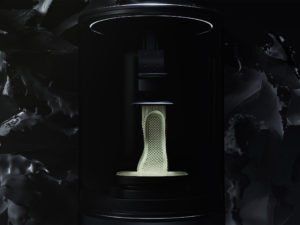The 3D printing world is getting serious, a view of an expert
Earlier this week, Sculpteo released the third edition of its annual State of 3D Printing report, which covers additive manufacturing trends with direct input from industry participants. As the report showcases through feedback from nearly one thousand respondents, the 3D printing industry has seen significant growth in recent years, with trends in usage and applications shifting since the 2016 and 2015 versions. I had the opportunity to learn more about the recent report’s findings directly from Sculpteo CEO and Founder Clément Moreau, as we talked through some of the key points raised in this year’s edition.
“IT IS OUR DECLARED OBJECTIVE TO SUPPLY OUR CUSTOMERS WITH COMPONENTS OF EXCEPTIONAL QUALITY FROM ONE SINGLE SOURCE. WE INTEND TO ACHIEVE THIS OBJECTIVE AS WE MOVE FORWARD WITH EOS AS A DEPENDABLE PARTNER AND LONG-TERM SUPPLIER.”
There’s one thing that all 3D printing industry reports have agreed on recently, and that’s that this industry is growing and changing shape — and quickly. The still-young industry surrounding additive manufacturing is exponentially dynamic at the moment, and Moreau was thoughtful in providing his insights into the information Sculpteo collected recently.
As Sculpteo has been creating these reports for three years now, I asked him if there had been any surprises from the most recent data collection.
“One interesting thing,” he said, “is that metal is of course still very important in the mind of the user and we see that, but SLA is also very important. I was not expecting this to come up so much. In one year, every time we go to a tradeshow, we see only metal 3D printing; every discussion is about aircraft engines, how do we make serious metal parts, make parts of planes, make parts of engines — this is one discussion we see everywhere. But with the people, the message is very, very important, and SLA is getting into the game.”
He continued, “Some things though were not unexpected. We believe a main source of developments is that Carbon and HP deployed very interesting machines and very interesting materials in 2016. This has been very important for 3D printing.”

Earlier this week, Sculpteo released the third edition of its annual State of 3D Printing report, which covers additive manufacturing trends with direct input from industry participants. As the report showcases through feedback from nearly one thousand respondents, the 3D printing industry has seen significant growth in recent years, with trends in usage and applications shifting since the 2016 and 2015 versions. I had the opportunity to learn more about the recent report’s findings directly from Sculpteo CEO and Founder Clément Moreau, as we talked through some of the key points raised in this year’s edition.
“This is one of the main questions: what should we make, what should we invent, where should we innovate if we want 3D printing to become a real mass manufacturing technology?” he said.
“It all goes back to the variety of materials. We need the right materials for every application, we need the right option for everyone and for each application. We don’t believe there will be one silver bullet, one machine, one material, to solve everything. Still we think it’s due to variety, what we can afford today, what is available in rigid materials, in flexible materials, one day in conductive materials; these are very important facts. We need to have materials that are exactly suitable for each application, for each vertical. Today, this still is very lacking. Today in the 3D printing world, a lot of people, a lot of machine manufacturers believe there will be one silver bullet.”
He used SLS technology as an example here, noting that “pretty much everyone is using polyamide parts, but if we convert to the reality of using polymers in industry, polyamide is very low; why should we have polyamide on SLS only?” This, he said, was not very logical, and the industry needs to have a material for each application:
“If one needs a stronger plastic than polyamide, let’s have stronger, if one needs cheaper, let’s have cheaper. The solution is to adapt to each problem, we think that’s what’s really lacking today.”
As plastics maintain their dominance among 3D printing materials, a broader variety of offerings can only stand to benefit everyone. Plastic 3D printing technology remains the best understood and most utilized — but of course it could be better still. We’re seeing increasing efforts to enhance materials capabilities, such as with major players in the chemical field from BASF to SABIC working to enhance availability of high-strength and specialized materials. Many of these companies are turning as well to collaborative efforts, working alongside big name companies in additive manufacturing to create compatible, optimized materials.
As 3D printing expands its presence as a global industry, Sculpteo’s State of 3D Printing report looked to the similarities and differences in markets around the world. The 2017 report focused primarily on the markets in the US and Europe, so I asked Moreau how these two markets compared. He told me that the three main markets in additive manufacturing are America, Europe, and Asia, though the Asian markets are not so transparent in operations. They have “low data about Africa or South America.” We looked to the US and Europe for comparisons and contrasts in these two large and well-reported markets, as about 30% of this year’s survey respondents were from the US and 60% reported from Europe.
One of the interesting facts in difference is in the way people see their own sector, their own industry,” Moreau explained. “Europeans still consider that 3D printing is mainly for prototyping, whereas Americans of course think it is for prototyping, but also see it for mass manufacturing. We also see a big difference in how people envision their competition. Europeans think they are the best of competition, or think they use 3D printing more than competitors, whereas Americans think others use it more, and so there is probably a difference in the way people envision competitors.”
As we looked at adoption across the board, Sculpteo’s user segmentation proved an interesting grounds for exploration; the company’s report categorizes users as either General Users or Power Users, with the latter “defined by its advanced performance in additive manufacturing,” as the report defines it.
“They embrace the potential of 3D Printing and perform better than the General Users. Why do they succeed? They make heavy use of 3D Printing and they use a lot of its many possibilities. To summarize, they are advanced users and high performers,” the State of 3D Printing reports. “The proportion of survey respondents we can identify as Power Users went from 26% last year to 30% this year. This increase shows that the gap is decreasing between the two categories.”
As Power Users are increasing, I asked Moreau his thoughts on the best way for users to move into that category, and the way that exposure to expertise enhances such opportunities.
“From the beginning, we saw there is a group inside the audience of the study, even two and three years ago, this inside audience group that use 3D printing a lot more. Those guys are who we call the Power Users,” he told me. “We try to see are they really using the technology more or are they really more successful in their business, their R&D, their development. What we see this year is more people in technical areas, which means 3D printing is not only in the business world anymore, but there are a lot of engineers with a technical background. This is really something very important to see for us, that there are more technical people going into this game. It’s not only the product marketer or the chief marketer who see 3D printing as a business opportunity, this is a real thing used by engineers today.”
“From the beginning, we saw there is a group inside the audience of the study, even two and three years ago, this inside audience group that use 3D printing a lot more. Those guys are who we call the Power Users,” he told me. “We try to see are they really using the technology more or are they really more successful in their business, their R&D, their development. What we see this year is more people in technical areas, which means 3D printing is not only in the business world anymore, but there are a lot of engineers with a technical background. This is really something very important to see for us, that there are more technical people going into this game. It’s not only the product marketer or the chief marketer who see 3D printing as a business opportunity, this is a real thing used by engineers today.”
With all the changes in dynamic and shape of the 3D printing industry, such reports as the State of 3D Printing remain a valuable resource. Annual updates in such reports provide regular updates of the state of being, though even the experts often note that the industry is changing so much lately that it is almost impossible to even name every factor at play, much less analyze what each new player and new technology might bring to the table.
That said, I asked Moreau about his expectations for the coming year in additive manufacturing — a tricky prediction, to be sure, but important in a forward-looking field.
“One thing of course that we cannot see in the report, but that we think is very important, in 2017 we should see real solutions coming. It is important to see users not very aware of this, because they are not aware of the need for better software. It will take a little time for them to understand what is the value of the software. What we see from inside and from big software brands, we believe 2017 will be the year of software. 2015 was the year of SLA and 2016 of metal; next year’s conversation will be about software — integration of software, better simulation tools, more solutions,” he told me. “This is something we think should happen next year.”
For its part, Sculpteo has been dedicating resources to bettering software options; the last time I spoke with Moreau, at CES in January, he took me through a run-through of their newest solutions in software for metal 3D printing, demonstrating the Agile Metal Technology platform. Software does need to stay in focus for the machines and materials emerging in 3D printing to live up to their built-in potential, and is indeed key to the growth of the overall industry.
As the state of 3D printing continues to change and reform with new technologies, new offerings, and new adoptions, reports such as this from Sculpteo will remain critical to participants’ understanding of where the industry is now — and where it’s going. We look forward to continuing to speak directly with those behind such efforts to provide details right from the source.











